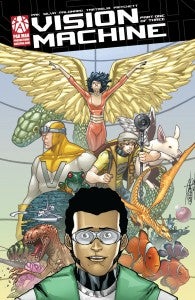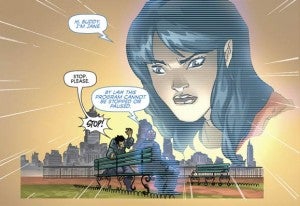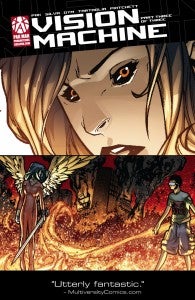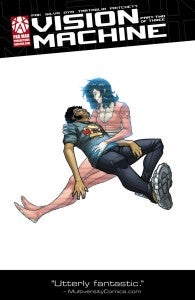Greg Pak, best known for work-for-hire projects like Planet Hulk and The Incredible Hercules, has spent much of his time recently working on a lesser-known project that pushes the boundaries of digital comics, both in execution and distribution.Titled The Vision Machine, Pak’s story is a near-future science fiction tale in which a device is invented that allows its user to create movies essentially with their mind. The result is a democratization of entertainment that makes film more like comics, where the visuals and special effects are limited only by the imagination of the artist–but at a cost. Privacy is constantly being challenged by the needs of the companies with whom we entrust our personal data in the real world (think about how much Facebook has on you, and that they use it to sell advertising), but in the world of The Vision Machine, that’s even more pronounced.Pak, who announced an iPad app for The Vision Machine at New York Comic Con this year, joined ComicBook.com to discuss the project and the future of digital comics.Also, just so it’s been said, it’s available for free at the Vision Machine website as well as ComiXology.How would you describe The Vision Machine in simple terms, so I don’t get it wrong?Vision Machine is a sci-fi thriller first and foremost; it’s about the world in which we live. Within days or within years, we’re going to see technology released by the biggest tech companies in the world that will allow you to record anything you look at just by thinking about it and share it with the world.You’ll not only be able to record it just by thinking–you’ll be able to edit it, you’ll be able to add special effects…and Vision Machine imagines a world in which these magic glasses allow you to basically share your dreams; if you can imagine it, you can share it and that kind of media making is going to change everything. Putting that power to create in the hands of literally anybody who can put on a pair of glasses will transform the world in ways that we can only begin to imagine right now.That’s what Vision Machine is all about; it’s about these three young friends who get hold of these amazing glasses the iEye, and it’s created by Sprout computers…and embrace the incredible opportunities that arise. But then of course at a certain point the other shoe drops because there’s a whole host of not only copyright and trademark-related kinds of things that arise but these massive questions of privacy and surveillance. And mayhem ensues.The book itself was funded by the Ford Foundation as a way to help independent media makers imagine the changes that are actually coming. The exciting thing is that recently we got funding from ITVS, the Independent Television Service, which usually funds documentaries that you see on PBS, that’s what they’re best known for. But they’re branching out and doing some other kinds of things and they thought that this was a fun project to get involved with. They provided some funding that allowed us to make an iPad app version of the graphic novel.The iPad app is doing something–putting together some things in a certain way that I haven’t seen yet with digital comics. There’s a lot of great stuff being done, including the Marvel Infinite stuff and Madefire and a bunch of other folks who are doing interesting things with interactive digital comics…but we’re taking it a couple of steps further in that we’ve got a full-voice soundtrack as well as a full music soundtrack. So every word that’s in the book is spoken and performed by brilliant actors including Phil LaMarr, who is well-known for his work on everything from The Simpsons to Samurai Jack to Young Justice.Actually I went to college with Phil and it was just an incredible amount of fun getting together with him again. We were togehter in an improv comedy group when we were in college and it was a blast doing stuff with him again on this.It also has great animation. Not everything is animated but there’s great, selective use of animation including some really nifty 3-D animation. You swipe through panel by panel; you can also pinch to zoom to get a better look at the panels and on certain panels you can punch a button and see the panel in 3-D, see the different layers that went into making it.As the dialogue runs the word balloons come up in order; sound effects are all animated and do cool things and then on top of all that we have buttons that you can tap from time to time that will give you more stuff while you’re reading, like IRL buttons for “in real life,” which give you concept art or also little videos and we have people talking about real-world ramifications of the stuff that comes up in the book.We’ve got folks like Andy Ihnatko, who is a legendary tech journalist talking about some of the tech-related stuff that’s happening and also Jonathan Coulton–internet superstar and musician Jonathan Coulton, who has been on the forefront of the digital revolution and how it affects artists–has a lot of interesting things to say about how this technology is changing things and what the potential and the potential dangers are as well.Also there’s a Twitter feed that’s built into it – as you read the book if you activate that, you’ll see any tweets that people post using the #VisionMachine hashtag. So using that feature, for example, I could do a live Q&A via the app where people could be reading the book and then seeing a live commentary track.Back when the iPad first came out, I wrote this essay thinking about all the things that it made possible for comics and this is a way to finally explore some of those in a crazy way. I’m really excited about it.












